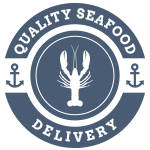Also known as silver salmon, the coho salmon is a generally mid-sized, moderately flavorful fish and one of the most popular varieties of wild salmon. Wild-caught coho salmon will generally range from 7 pounds to 15 pounds with an average length of 24-28 inches. Some of the largest salmon of this species can grow to almost four feet long and weigh 30-35 pounds.
Their color is, indeed, silver for much of their lives with a blue stripe on their dorsal side. When they migrate back to freshwater to spawn, their sides can become a bright red with additional dark spots for markings. The color of their flesh is more often described as an orange-red or even peach-like color but can also vary considerably according to their diet.
| Company | $/lb | Min. Order Cost | Reviews | Rating | Website |
|---|---|---|---|---|---|
| Global Seafoods | $25.00 | $125.00 | 1,130 | 4.6 | website |
| Sizzlefish | $28.55 | $99.95 | 341 | 4.9 | website |
| Lummi Island Wild | $28.88 | $65.00 | 21 | 4.8 | website |
| Seabear Smokehouse | $28.88 | $65.00 | 273 | 5.0 | website |
| Vital Choice | $35.11 | $79.00 | 23,132 | 4.8 | website |
| Sea to Table | $31.00 | $23 | 2,784 | 4.7 | website |
Coho Salmon Harvesting
Trollers and purse seiners are the most popular fishing vessels for coho salmon harvesting, along with some gillnetting. Many commercial fisheries will include coho salmon as part of their purse seiner fishing permits. Many independent and small-scale fishing operations prefer the more intimate experience of hook-and-line trollers. Some even market their salmon as being caught one hook at a time. There is generally marginal difference in both quality and cost between troll-caught and purse seine salmon. Coho salmon harvests are typically smaller but also more stable than other types of wild-caught salmon. For almost a generation now, the Alaskan coho salmon harvest has been between 4-5 million fish per year. A late-season salmon, most coho harvesting occurs between August and September.
Coho Salmon Sport Fishing
Due their size, taste, and preference for smaller streams, coho salmon is extremely popular among sports fishermen. Silver salmon can be found in many Pacific watersheds from Japan to Alaska to California. People have also been relatively successful in being transplanted coho to different locations. They can be found in the Great Lakes and other select watersheds around the world. It can be an amazing experience to clean, cook, and serve your own personally caught coho salmon. Whether from local fishermen or from the Internet (Ex: Delta Clearwater River), you can find sport fishing tips for wild-caught coho salmon in your area.
Coho Salmon: Nutritional Health Information
Like all wild-caught salmon, the silver species is quite low in mercury and other toxin levels when compared to most types of seafood. Most people can eat this fish several times a week or even daily without worrying too much about their mercury levels. That said, the nutritional quality of wild-caught coho salmon is largely determined by the fish’s diet and the water quality of its habitat. A mix of insects and plankton as younger salmon and other fish in adulthood, their diet isn’t the best and isn’t the worst. At 3-5 years, their life cycle isn’t the shortest or the longest for wild seafood.
Research the water quality in your local fishing areas if you can, but most of the local water quality information we’ve been able to find pertains to swimming safety. We do know that the Great Lakes region generally struggles with significantly higher mercury levels. However, locally-sourced salmon is usually perfectly safe in modest quantities. Plus, you save on the shipping costs. Alternatively, Alaska generally has the best water quality and the largest harvests, so there are several choices to buy wild-caught Alaskan coho salmon.
Take note of our Affiliate Relationships that may exist with this page and companies listed on it.

